ODA applauds release of Ohio’s first ‘State Oral Health Plan’

Source: Oral Health Screening Survey of Third Grade Schoolchildren in Ohio 2017-18, Ohio Department of Health
The Ohio Dental Association recently praised the release of the “State Oral Health Plan” from Oral Health Ohio. This plan includes many proactive and positive policy recommendations and identifies clear paths forward to build on Ohio’s recent successes in improving oral health for Ohioans.
Over the last several years, the State of Ohio has seen significant progress in access to oral health care thanks to many coordinated efforts in both the private and public sectors. Working with many partners and enacting new dental health policies through legislation, the state has expanded school-based sealant programs and school-based health centers, expanded the number of dentists and dental hygienists practicing in underserved communities in both rural and urban areas, and expanded the use of tele-dentistry to extend dental care to underserved populations. Additionally, the state has expanded use of non-invasive techniques, including the application of Silver Diamine Fluoride, for at-risk populations to treat tooth decay.
While the overall improvement in access to dental care in Ohio is impressive, more still needs to be done. As outlined in the State Oral Health Plan, oral health disparities still exist especially within the Medicaid eligible and uninsured populations and communities of color.
The State Oral Health Plan can serve as a roadmap to ensuring that all Ohioans have access to the same high quality oral health care.
ODA President Dr. David Kimberly said “we are poised to continue the momentum we have built over the last few years to ensure all Ohioans have access to the full range of oral health services that only a dentist can provide because we know that oral health is integral to overall health.”
The “State Oral Health Plan” comes on the heels of a series of reports demonstrating Ohio’s improved standing on oral health indicators.
WalletHub recently released a report showing that Ohio ranks 11th out of 50 states for oral health.
- The WalletHub report measured various oral health indicators including:
- Share of adolescents who visited a dentist in the past year.
- Share of adults who visited a dentist in the past year.
- Number of dentists per capita.
- Number of free or low-cost dental clinics per capita.
- Share of people who receive fluoridated water through public water systems.
- Presence of school-based dental sealant programs.
These results are consistent with the most recent “Oral Health Screening Survey of Third Grade School Children” released by the Ohio Department of Health just prior to the pandemic. That report states:
“Overall, since 2004, there has been a modest decrease in the percentage of Ohio third graders with a history of tooth decay that is statistically significant. The average decline between each survey (2005, 2010, 2015, 2018) is 0.9%. The prevalence of untreated cavities is trending downward, while the prevalence of dental sealants is trending upward. The percentage of children with a dental visit in the past year has slightly increased.”
The ODH survey reveals that 84% of Ohio third graders had a dental visit within the previous year, which is well above the national target set by CMS of 49%. The screening survey also showed that only 7% of parents reported that they have trouble getting dental care for their child, a decrease from 12% reported in 2013-15.
The Third Grade Survey also reveals that Ohio is meeting other national oral health targets set by the U.S. Department of Health and Human Services.
